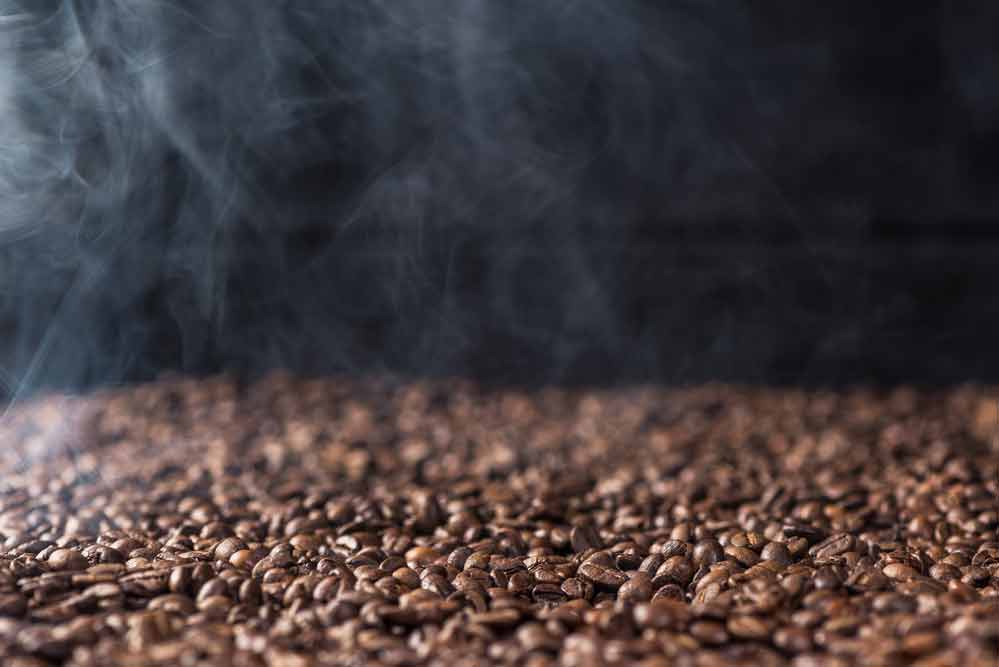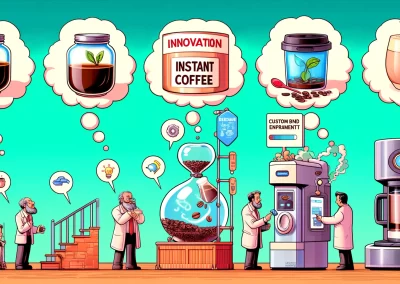Coffee Beans come in many varieties and coffee is enjoyed by millions of people worldwide every day, One of the most significant factors that determine the taste of coffee is the type of coffee bean used. There are two main types of coffee beans: Arabica and Robusta. Arabica beans are known for their delicate, nuanced flavors and low acidity. Robusta beans, on the other hand, have a stronger, more bitter taste and higher caffeine content.
Arabica beans are the most commonly used coffee beans worldwide, accounting for around 60% of coffee production. They grow at higher altitudes and have a more complex flavor profile, with notes of fruit, nuts, and chocolate. Robusta beans, on the other hand, are grown at lower altitudes and have a more straightforward flavor profile, with notes of earthiness and bitterness. They are often used in espresso blends for their strong, bold flavor.
The type of bean used in a particular coffee affects its taste, aroma, and body. The roast level of the bean also plays a significant role in determining the flavor of the coffee. In the following article, we will explore the different types of coffee beans and how they affect the flavor of the coffee, as well as the best brewing methods for each type of bean.
Types of Coffee Beans
When it comes to coffee, the type of bean used can have a significant impact on the taste of the final product. There are four main types of coffee beans: Arabica, Robusta, Liberica, and Excelsa. Each of these beans has unique characteristics that affect the flavor, aroma, and body of the coffee.
Arabica Beans
Arabica beans are the most commonly used coffee beans and are known for their delicate and complex flavor profiles. They are grown in high-altitude regions and require specific growing conditions, making them more expensive than other types of beans. Arabica beans have a lower caffeine content than other beans, resulting in a smoother, less bitter taste.
Robusta Beans
Robusta beans are grown in lower-altitude regions and are known for their strong, bitter taste. They are used in many espresso blends because of their high caffeine content and thick crema. Robusta beans are also less expensive than Arabica beans, making them a popular choice for commercial coffee production.
Liberica Beans
Liberica beans are a less common type of coffee bean, known for their unique and fruity flavor profiles. They are grown in specific regions of Africa and Southeast Asia and are often used in blends to add complexity to the final product.
Excelsa Beans
Excelsa beans are a type of coffee bean that is often used in blends to add a unique flavor profile. They are grown in specific regions of Southeast Asia and have a tart and fruity taste. Excelsa beans are often used in combination with other beans to create a unique and complex flavor.
In conclusion, the type of coffee bean used can have a significant impact on the taste of the final product. Each type of bean has unique characteristics that affect the flavor, aroma, and body of the coffee. Whether you prefer a delicate and complex flavor or a strong, bitter taste, there is a coffee bean out there for you.
How Coffee Beans Affect Taste
When it comes to coffee, the type of bean used can have a significant impact on the final taste of the brew. There are many different types of coffee beans available, each with its own unique characteristics. In this section, we’ll explore some of the factors that can affect the taste of coffee beans.
Altitude and Region
One of the most significant factors that can impact the taste of beans is the altitude at which they are grown. Coffee grown at higher altitudes tends to have a more complex flavor profile, with a higher acidity and brighter, fruitier flavors. In contrast, coffee grown at lower altitudes tends to be fuller-bodied, with a more earthy or woody flavor profile.
The region in which the coffee is grown can also impact its flavor profile. For example, coffee grown in Latin America tends to have a chocolatey or nutty flavor, while coffee grown in Eastern Africa often has a more citrusy or floral flavor profile. Coffee grown in West Africa can have a smoky or spicy flavor.
Roast Level
The roast level of can also have a significant impact on their taste. Lighter roasts tend to have a brighter, more acidic flavor profile, while darker roasts tend to be fuller-bodied with a more caramelized or nutty flavor. Medium roasts offer a balance between the two.
Processing Method
The processing method used can also impact their flavor profile. There are two primary methods: wet processing and dry processing. Wet-processed coffee tends to have a cleaner, brighter flavor profile, while dry-processed coffee often has a more earthy or fruity flavor.
In conclusion, the type of bean used can have a significant impact on the final taste of the brew. Factors such as altitude, region, roast level, and processing method can all play a role in determining the flavor profile of the coffee. When choosing coffee beans, it’s essential to consider these factors to find the best coffee beans for your taste preferences.
Flavors and Aromas
When it comes to coffee, the flavors and aromas can vary greatly depending on the type of bean used. Here are some of the most common flavor and aroma profiles you can expect from different types of beans.
Fruity Flavors
Coffee beans that have a fruity flavor profile often have notes of berries, citrus, or tropical fruits. These flavors are often found in beans from Ethiopia, Kenya, and some Latin American countries.
Nutty Flavors
If you’re looking for a coffee with a nutty flavor profile, you might want to try beans from Brazil, Colombia, or Indonesia. These beans often have notes of hazelnut, almond, or walnut.
Chocolate and Caramel
Beans from Central and South America often have a chocolatey or caramel flavor profile. These beans are often used in espresso blends and can be found in many coffee shops around the world.
Floral and Sweet
If you’re looking for a coffee with a more delicate flavor profile, you might want to try beans from Yemen or Ethiopia. These beans often have floral and sweet notes, with hints of jasmine, lavender, or honey.
Earthy and Woody
Beans from Sumatra or Sulawesi often have an earthy and woody flavor profile. These beans can have notes of tobacco, leather, or even mushrooms.
Smoky and Spicy
If you’re looking for a coffee with a bold flavor profile, you might want to try beans from Indonesia or Papua New Guinea. These beans often have smoky and spicy notes, with hints of black pepper or clove.
Overall, the type of coffee you choose can greatly affect the taste and aroma of your coffee. Whether you prefer fruity, nutty, chocolatey, or earthy flavors, there’s a coffee bean out there for everyone.
Caffeine Content
When it comes to coffee, caffeine is the chemical compound that gives it that energizing kick we all know and love. The amount of caffeine in coffee can vary greatly depending on the type of bean, the roast level, and the brewing method used.
Arabica vs. Robusta
The two most common types of coffee beans are Arabica and Robusta. Arabica beans are known for their mild, sweet flavor and lower caffeine content, while Robusta beans have a stronger, more bitter taste and a higher caffeine content.
On average, Arabica beans contain about 1.5% caffeine, while Robusta beans contain about 2.7% caffeine. However, it’s important to note that these are just averages and the actual caffeine content can vary depending on the specific bean and how it’s prepared.
Roast Level
The roast level can also affect the caffeine content. Contrary to popular belief, darker roasts actually contain slightly less caffeine than lighter roasts. This is because the roasting process breaks down some of the caffeine molecules.
Brewing Method
Finally, the brewing method used can also impact the caffeine content of coffee. Generally, the longer the brewing time, the higher the caffeine content. For example, espresso has a higher caffeine content than drip coffee because it’s brewed using a finer grind and a shorter brewing time.
Overall, understanding the caffeine content of different types of coffee beans can help you choose the right coffee for your needs. Whether you’re looking for a mild morning pick-me-up or a strong afternoon boost, there’s a coffee out there that’s perfect for you.
Popular Coffee Beans by Region
South America
South America is home to some of the most popular coffee beans in the world. Colombia is known for producing high-quality arabica beans with a mild, fruity flavor. Brazil is the largest coffee producer in the world and is famous for its rich, nutty beans. Other popular South American coffee beans include those from Costa Rica and Guatemala.
Central America
Central America is another region that produces high-quality coffee beans. Guatemalan beans are known for their bright acidity and complex flavor profile. Costa Rican beans have a mild, well-balanced flavor with hints of chocolate and citrus. Other popular Central American coffee beans include those from Honduras and Panama.
Africa
Africa is known for producing some of the most unique and flavorful coffee beans in the world. Rwandan beans have a bright acidity with notes of grapefruit and black tea. Ugandan beans have a rich, full-bodied flavor with hints of chocolate and nutmeg. Liberian beans have a sweet, fruity flavor with notes of apricot and peach.
Southeast Asia
Southeast Asia is home to some of the strongest and most complex coffee beans in the world. Vietnamese beans are known for their bold, dark flavor with hints of chocolate and spice. Indonesian beans, such as those from the Jember and Java regions, have a rich, earthy flavor with notes of tobacco and cedar.
India
India is another region that produces unique and flavorful coffee beans. Indian beans, such as those from the Karnataka region, have a full-bodied flavor with hints of spice and dark chocolate. Other popular Indian coffee beans include those from the Baba Budan region.
Overall, the type of bean used can greatly affect the taste of the coffee. Factors such as ideal growing conditions, harvesting methods, and pests can all impact the flavor profile of the beans. Additionally, the choice between arabica and robusta beans can also greatly impact the taste of the coffee. When choosing gourmet coffee, it’s important to consider the origin of the beans and the competitors in the market. Additionally, coffee rust can be a major threat to coffee production in certain regions, making it important to choose beans from areas that are less affected. Finally, coffee blends can be a great way to combine the unique flavors of different types of beans and create a truly unique and flavorful coffee experience.
Preparing Coffee
When it comes to preparing coffee, the process can be broken down into two main steps: grinding and brewing. The quality of the beans and the method used to prepare them can greatly affect the taste of the final product.
Grinding
Grinding your beans is an important step in the preparation process. The way you grind your beans can affect the taste and strength of your coffee. Here are some common grinding methods:
- Blade grinders: These are the most common type of grinder and are often found in most homes. They use a spinning blade to chop the beans into small pieces. However, this method can result in uneven grinds, which can affect the taste of your coffee.
- Burr grinders: These grinders use two revolving abrasive surfaces to grind the beans. They produce a more consistent grind, which can result in a better-tasting cup of coffee.
- Manual grinders: These are hand-cranked grinders that allow you to control the grind size. They are great for coffee enthusiasts who want to have more control over their coffee preparation.
Brewing Methods
Once your beans are ground, it’s time to brew your coffee. There are several different brewing methods available, each with its own unique taste and brewing time. Here are some popular brewing methods:
- Drip coffee: This is the most common method of brewing coffee. Hot water is poured over ground coffee beans, which then drips through a filter into a carafe. This method produces a clean and simple cup of coffee.
- French press: This method involves steeping coffee grounds in hot water for several minutes. The coffee is then pressed through a filter to remove the grounds. This method produces a rich and full-bodied cup of coffee.
- Espresso: This method uses high-pressure water to extract the flavor from finely ground coffee beans. It produces a strong and concentrated cup of coffee.
- Cold brew: This method involves steeping coffee grounds in cold water for several hours. The result is a smooth and less acidic cup of coffee.
No matter which brewing method you choose, the quality of your coffee beans and the way you prepare them can greatly affect the taste of your coffee. So, whether you’re a coffee drinker, a specialty coffee enthusiast, or a fan of drinks like americano, latte, cappuccino, iced coffee, macchiato, ristretto, or cold brew, taking the time to properly prepare your coffee can result in a delicious and satisfying cup. Visit Here for another article.










